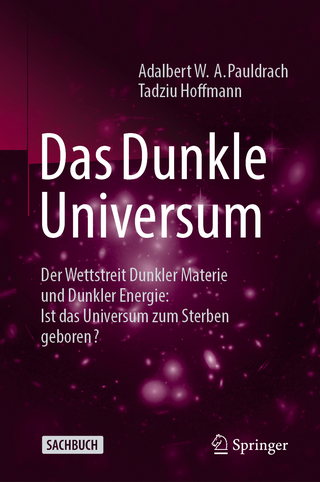
Galactic Dynamics
Princeton University Press (Verlag)
978-0-691-13027-9 (ISBN)
Since it was first published in 1987, Galactic Dynamics has become the most widely used advanced textbook on the structure and dynamics of galaxies and one of the most cited references in astrophysics. Now, in this extensively revised and updated edition, James Binney and Scott Tremaine describe the dramatic recent advances in this subject, making Galactic Dynamics the most authoritative introduction to galactic astrophysics available to advanced undergraduate students, graduate students, and researchers. Every part of the book has been thoroughly overhauled, and many sections have been completely rewritten. Many new topics are covered, including N-body simulation methods, black holes in stellar systems, linear stability and response theory, and galaxy formation in the cosmological context. Binney and Tremaine, two of the world's leading astrophysicists, use the tools of theoretical physics to describe how galaxies and other stellar systems work, succinctly and lucidly explaining theoretical principles and their applications to observational phenomena. They provide readers with an understanding of stellar dynamics at the level needed to reach the frontiers of the subject.
This new edition of the classic text is the definitive introduction to the field. * A complete revision and update of one of the most cited references in astrophysics * Provides a comprehensive description of the dynamical structure and evolution of galaxies and other stellar systems * Serves as both a graduate textbook and a resource for researchers * Includes 20 color illustrations, 205 figures, and more than 200 problems * Covers the gravitational N-body problem, hierarchical galaxy formation, galaxy mergers, dark matter, spiral structure, numerical simulations, orbits and chaos, equilibrium and stability of stellar systems, evolution of binary stars and star clusters, and much more * Companion volume to Galactic Astronomy, the definitive book on the phenomenology of galaxies and star clusters
James Binney is professor of physics at the University of Oxford. His books include "Galactic Astronomy". Scott Tremaine is the Richard Black Professor of Astrophysics at the Institute for Advanced Study and a member of the National Academy of Sciences. Both are fellows of the Royal Society.
Preface xiii Chapter 1. Introduction 1 1.1 An overview of the observations 5 1.2 Collisionless systems and the relaxation time 33 The relaxation time 34 1.3 The cosmological context 37 Chapter 2. Potential Theory 55 2.1 General results 56 The potential-energy tensor 59 2.2 Spherical systems 60 2.3 Potential-density pairs for attened systems 72 2.4 Multipole expansion 78 2.5 The potentials of spheroidal and ellipsoidal systems 83 2.6 The potentials of disks 96 2.7 The potential of our Galaxy 110 2.8 Potentials from functional expansions 118 2.9 Poisson solvers for N-body codes 122 Chapter 3. The Orbits of Stars 142 3.1 Orbits in static spherical potentials 143 3.2 Orbits in axisymmetric potentials 159 3.3 Orbits in planar non-axisymmetric potentials 171 3.4 Numerical orbit integration 196 3.5 Angle-action variables 211 3.6 Slowly varying potentials 237 3.7 Perturbations and chaos 243 3.8 Orbits in elliptical galaxies 262 Chapter 4. Equilibria of Collisionless Systems 274 4.1 The collisionless Boltzmann equation 275 4.2 Jeans theorems 283 4.3 DFs for spherical systems 287 4.4 DFs for axisymmetric density distributions 312 4.5 DFs for razor-thin disks 329 4.6 Using actions as arguments of the DF 333 4.7 Particle-based and orbit-based models 338 4.8 The Jeans and virial equations 347 4.9 Stellar kinematics as a mass detector 365 4.10 The choice of equilibrium 376 Chapter 5. Stability of Collisionless Systems 394 5.1 Introduction 394 5.2 The response of homogeneous systems 401 5.3 General theory of the response of stellar systems 417 5.4 The energy principle and secular stability 423 5.5 The response of spherical systems 432 5.6 The stability of uniformly rotating systems 439 Chapter 6. Disk Dynamics and Spiral Structure 456 6.1 Fundamentals of spiral structure 458 6.2 Wave mechanics of differentially rotating disks 481 6.3 Global stability of differentially rotating disks 505 6.4 Damping and excitation of spiral structure 518 6.5 Bars 528 6.6 Warping and buckling of disks 539 Chapter 7. Kinetic Theory 554 7.1 Relaxation processes 555 7.2 General results 559 7.3 The thermodynamics of self-gravitating systems 567 7.4 The Fokker Planck approximation 573 7.5 The evolution of spherical stellar systems 596 7.6 Summary 633 Chapter 8. Collisions and Encounters of Stellar Systems 639 8.1 Dynamical friction 643 8.2 High-speed encounters 655 8.3 Tides 674 8.4 Encounters in stellar disks 685 8.5 Mergers 695 Chapter 9. Galaxy Formation 716 9.1 Linear structure formation 717 9.2 Nonlinear structure formation 733 9.3 N-body simulations of clustering 751 9.4 Star formation and feedback 760 9.5 Conclusions 765 Appendices A. Useful numbers 770 B. Mathematical background 771 C. Special functions 785 D. Mechanics 792 E. Delaunay variables for Kepler orbits 805 F. Fluid mechanics 807 G. Discrete Fourier transforms 818 H. The Antonov Lebovitz theorem 822 I. The Doremus Feix Baumann theorem 823 J. Angular-momentum transport in disks 825 K. Derivation of the reduction factor 830 L. The diffusion coefficients 833 M. The distribution of binary energies 838 References 842 Index 857
| Reihe/Serie | Princeton Series in Astrophysics |
|---|---|
| Zusatzinfo | 16 color illus. 205 halftones. |
| Verlagsort | New Jersey |
| Sprache | englisch |
| Maße | 152 x 235 mm |
| Gewicht | 1276 g |
| Themenwelt | Naturwissenschaften ► Physik / Astronomie ► Astronomie / Astrophysik |
| ISBN-10 | 0-691-13027-2 / 0691130272 |
| ISBN-13 | 978-0-691-13027-9 / 9780691130279 |
| Zustand | Neuware |
| Haben Sie eine Frage zum Produkt? |
aus dem Bereich


